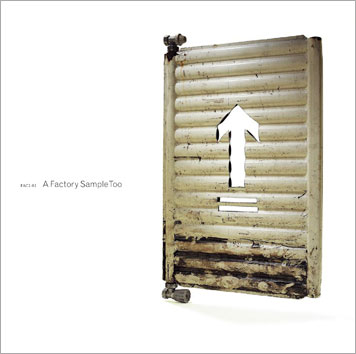
A Factory Sample Too, 7-inch EP. Design by Mat Cook, Intro. 1995.
Tony Wilson, founder of Factory records, died on last Friday, August 10. He'd been fighting cancer for some time. Wilson had many claims to fame: he was a successful television presenter; a music industry impresario of flawed and maverick genius; a professional Mancunian; a witty and literate man who wrote a classic pop autobiography; and he was one of the shrewdest patrons of graphic design there has ever been.
Tony Wilson was the Colonel Tom Parker of postmodern pop. Just as the Colonel had used fairground astuteness to turn Elvis into the first electronic-age pop star, Wilson deployed his Cambridge education to turn Factory's roster of acts — Joy Division, New Order, Happy Mondays, Durtti Column, and others — into the first wave of postmodern pop stars. Wilson knew how pop myths were made, and he spun them around his bands, around the doomed Factory empire, and around his own career. He did it with style, wit and a lot of black Armani. As a myth builder par excellence, Wilson used all the media-age tools at his disposal, but none more effectively than graphic design.
I met Wilson in 1994. He was charming, unreliable and totally unlike the other record company people I dealt with at the time. Wilson never let you forget that he'd graduated with a degree (third class) in English from Jesus College, Cambridge. He never missed a chance to tell you that he knew his Goethe from his Boethius. In the two-page foreword to his book, 24 Hour Party People: What the Sleeve Notes Never Tell You, he manages to weave in references to Voltaire, the Balfour Declaration and Mark Twain.
By the time I got to know Wilson, the Factory dream was over. So too was Madchester and the frazzled Acid House hallucination that Wilson provided with an ancestral home in the shape of The Haçienda. He was about to launch Factory Too, in collaboration with London Records, part of PolyGram. Peter Saville, newly returned from LA, had created the logo — two words set in Rotis that hinted at ennui and a lack of conviction on the part of both designer and label boss.
Wilson phoned from his Jaguar and announced that he was coming to see me. He wanted my studio to design A Factory Sample Too. Just as the original Factory had been launched with a double 7-inch EP (A Factory Sample), the second coming of Factory was to be celebrated with the release of another EP. Accompanied by his glamorous companion and business partner Yvette Livesey, Wilson briefed us on the project. But there was something missing: the bands were dreadful, and Wilson's patter, although as effervescent as ever, rang hollow.
He was a thrilling client, full of praise and enthusiasm: in Mathew Robertson's survey of Factory's graphic legacy, Wilson explains his attitude to graphic design: "Why was packaging important to us? Because the job was a sacred one. Music had transformed our young lives, children of the sixties all. And now we were in the privileged position of putting out records ourselves. Does the Catholic Church pour its wine into mouldy earthenware pots? I think not.'"
I worked with him off-and-on for two years — mainly on his In The City project, an annual music festival and conference — but getting paid was always difficult, and I realized I was doing the work because I was in thrall to the Factory myth, the Wilson myth, and the role that graphic design played in that mythos.
In his book (which he writes in the third person), Wilson describes meeting Peter Saville for the first time: "...a sort of 20-year-old Brian Ferry look-a-like with searingly intelligent eyes turned up at the Granada canteen to see Wilson over a cup of GTV coffee. Peter showed Wilson a book on Jan Tschichold. He showed him the Penguin Crime covers from 1941, the constructivist play posters from the 1920s and the cover of the 1965 Hoffmann-Laroche catalogue (the Swiss chemical boys who did so much for the neural pathways in the second-half of the century in question)."
Wilson recognized Saville's genius. But he also recognised graphic design's potential to be spun into the fabric of the Factory legend alongside the music, the drugs, the guns, and the deaths. Nor was it only Saville's cool postmodernism that Wilson championed. He also recognized the more rigorous genius of 8vo, and the anarcho-wierdness of Central Station Design.
In their book On The Outside, 8vo quote Wilson as saying, "The problem with 8vo is that they are bigger than the music," but as they point out, it didn't feel like that to them. In Central Station, Wilson found a graphic sensibility — the antitheses of Savile and 8vo's — to match the ramshackle pharmaceutical grandeur of Happy Mondays, who ironically would become the agents of Factory's demise.
The last time I saw Wilson was in 2005 at a seminar in Manchester about record sleeve design. He was the host. The audience was mainly made up of young Manchester designers attracted by a panel that included Ian Anderson (Designers Republic) and Ben Drury (the Mo'Wax designer). Wilson presided over the discussion. He did it with his usual flair and well-practiced exhibitionism. But I noticed the audience growing restless with his anecdotal references to Factory's glorious past. And although I was still in awe of his louche and foppish charm, the locals took a more critical stance: it was not uncommon to walk down the street with him in Manchester and for locals to roll down their car windows and shout abuse at him. It never seemed to bother him: quite the opposite.
As a keen, pop culture anthropologist, Tony Wilson will have known during his last days that nothing improves a reputation like a premature death. He will have known that his greatest act of myth-making was his own death. Anthony H. Wilson, RIP.
